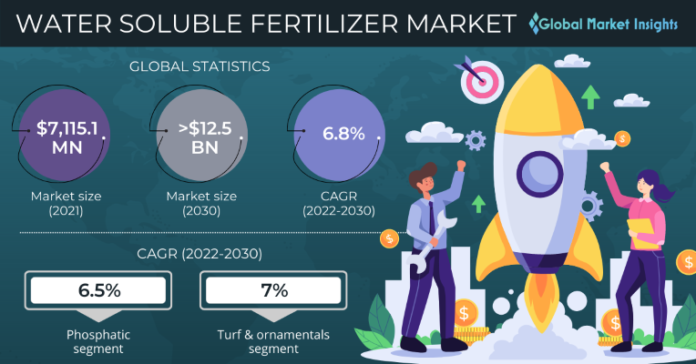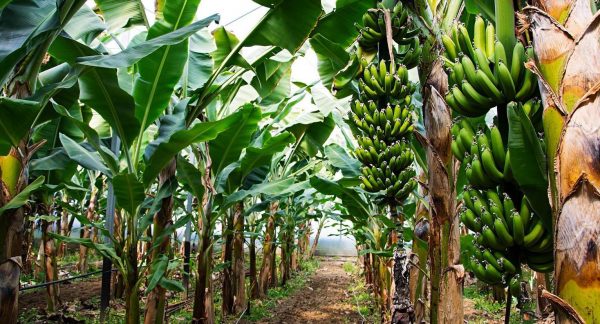Driven by the rising technological advancements in foliar and fertigation techniques, the global water soluble fertilizers market size is anticipated to exceed an annual valuation of over USD 12.5 billion by 2030.
Fertilizers have garnered immense importance in the last couple of decades, as it has become essential to ensure that the world’s food production and supply meet the steadily growing global population. Fertilizers cover almost an entire range of nutrients that are needed for optimal plant growth. With the escalating use of several agricultural products, a lot of focus has been laid on efficient fertilizers and fertilization methods. In consequence, it has been observed that the water soluble fertilizers market is depicting lucrative growth in recent times.
The efficient uptake of nutrients from the soil leading to higher plant efficiency is the most prominent factor that largely influences the economy of cultivation and crop yield. To that end, water soluble fertilizers are deployed for releasing the essential plant nutrients at the root zone wherein they are readily absorbed for uses elsewhere in the plant system since they are readily soluble in water. These fertilizers have different methods of application, including fertigation and foliar. They are also ideal for soil application depending on the requirements.
Another key benefit of using water soluble fertilizers is the ease of controlling the exact amount of nutrients that are available to the plants while reducing the accumulation of salts in the soil. In fact, these fertilizers can be dissolved in water as well as easily added or leached out of the soil.
Demand for nitrogenous water soluble fertilizers to grow at a robust pace
Considering the collective inclination for nitrogen as an essential nutrient that promotes plant growth, development, and reproduction, the utility of nitrogenous water-soluble fertilizers has grown multifold in the latest years. Apart from controlling the processes that make proteins important to new protoplasm in the cells, nitrogen is also essential for the production of chlorophyll as it is responsible for leaf growth, the overall size, as well as vigor. More than 100 million tons of nitrogen are applied in the form of fertilizers to crops in a bid to promote stronger and better growth.
The soaring consumption of corn across most parts of the world is another significant contributor to the adoption of nitrogenous water soluble fertilizers. Lately, with the ongoing technological interventions and the higher availability of cheap renewable sources, the production of nitrogen fertilizers is easily achieved with local energy sources.
India to record significant gains in the global water soluble fertilizers market
In view of the rising commercialization of agriculture across the Indian sub-continent, water soluble fertilizers are at the forefront of the regional farming sector, driven by the demand for higher productivity from every unit of land. Farmers across the country are increasingly turning to these fertilizers to counter nutrient deficiency. This is because soil fertility is generally poor in most regions owing to the dearth of micronutrients and macronutrients on account of continuous cultivation for a very long time.
The rising fuel costs and environmental concerns have increased the demand for water soluble fertilizers in the country. India is home to a large number of government-led, and small-scale, as well as large-scale fertilizer manufacturers, who are actively involved in several growth-driven strategies to cater to the increasing fertilizer demand in the region. In consequence, the country is witnessing a wider production range of fully soluble fertilizers in fertigation systems for managing both nutrients and water to maximize both yield and quality. To cite an instance, Gujarat Agro Industries Corporation, a renowned government agency, in January 2020, launched imported water-soluble fertilizers in Ahmedabad for encouraging the use of high-grade agri-inputs. The launch was also targeted at enhancing the precision farming sector in the country and producing fruits and vegetables equivalent to global standards for better remuneration.
The rising acceptance of cereals, cotton, pulses, cane, and tea in the country will have a profound impact on the regional water soluble fertilizers market growth. The increasing production of fruits and flowers has also pushed the preference for these fertilizers as they not only enhance the fruit size, uniform color, luster, and taste, and yield of fruit, but also limit flower & fruit dropping.
What does the future hold for water soluble fertilizers market?
The demand for water soluble fertilizers is expected to showcase a meteoric rise in the foreseeable future, powered by the surging popularity of precision agriculture. In the wake of impending climatic change, a thriving need for higher productivity and quality of produce has become imminent. To that end, several organizations across most economies have introduced crop-specific as well as stage-specific water soluble mixtures of fertilizers.
The robust awareness about these fertilizers is also paving the path for novel innovations. As the global focus on sustainable agriculture increases and knowledge on the higher bioavailability of nutrients in water soluble fertilizers rises among the farming community, the adoption of these products will observe a commendable upsurge.
Source: https://www.gminsights.com/industry-analysis/water-soluble-fertilizers-market








